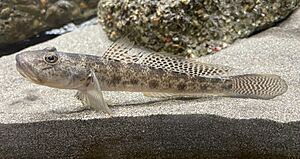Yellowfin goby facts for kids
Quick facts for kids Yellowfin goby |
|
|---|---|
 |
|
| Conservation status | |
| Scientific classification | |
| Synonyms | |
|
The yellowfin goby (Acanthogobius flavimanus) is a type of fish belonging to the goby family. It's also known by names like mahaze or Japanese river goby. This fish originally comes from Asia, found in countries like China, Japan, Korea, and parts of Russia. It has also spread to other places, becoming an introduced fish in areas like Australia, Mexico, and parts of the United States.
Contents
What Does the Yellowfin Goby Look Like?
This fish can grow to be about 25 to 30 centimeters (10 to 12 inches) long. It has a light brown body with darker marks and spots. A special feature is its bright yellow fins on its belly, which are joined together to form a cup shape.
The yellowfin goby also has two fins on its back. Scientists can tell this species apart from other gobies by looking at tiny pores on its head. They also check the spines and rays in its back fins, and the scales on its head and face. Most yellowfin gobies live for up to 3 years, but some can live longer.
Yellowfin Goby Life and Habitat
Yellowfin gobies spend most of the year living in rivers and streams. When winter arrives, they move to saltier places like bays and estuaries. Here, they live on the muddy or sandy bottom of the water.
Reproduction and Life Cycle
These fish breed when the water temperature is between 7 °C and 13 °C (44.6 and 55.4 °F). A single female fish can lay up to 37,000 eggs. Each egg is about 5.5 millimeters long.
The male goby builds a nest, which is a burrow up to 35 centimeters (14 inches) deep. Both the male and female fish might guard the eggs. If conditions are good, the eggs will hatch in about 28 days.
Yellowfin gobies can live in both fresh and salty water. They can move quickly between these different water types. Adult fish can even live their whole lives in freshwater. However, the baby fish, called larvae, usually grow up in saltwater.
What Do Yellowfin Gobies Eat?
The yellowfin goby eats many kinds of small creatures. Its diet includes tiny copepods and amphipods. They also eat small fish, mantis shrimp, and polychaete worms. Sometimes, they will eat fly larvae, clams, and other small organisms.
Who Eats the Yellowfin Goby?
Several animals hunt and eat the yellowfin goby. These include the yellow goosefish and the ocellate spot skate. Other predators are the Japanese whiting and the leopard shark. Some other fish, like the ashishirohaze and the suzuki, also prey on them.
Tiny Passengers: Parasites
Like many animals, yellowfin gobies can carry tiny organisms called parasites. These parasites live on or inside the fish. Some of these are types of flukes. It's important to always cook fish thoroughly before eating it to avoid any health risks from parasites.
The fish can also host other small creatures called copepods. One type of copepod, Anchistrotos kojimensis, was first found on a yellowfin goby.
Yellowfin Goby: An Introduced Species
The yellowfin goby is the largest type of goby found in the Sacramento-San Joaquin River system in California. It was first seen there in 1963. It likely arrived a few years earlier, possibly in ballast water from ships. Ballast water is water taken into ships for stability. It might also have come as eggs attached to animals like oysters on ship hulls.
Some people think anglers using the goby as bait helped it spread. Now, it's a very common bottom-dwelling fish in the rivers and Delta. It's also found in San Francisco Bay. Here, it has become an important food source for harbor seals.
However, the yellowfin goby can also affect the local ecosystem. It might compete for food and space with native fish, such as the tidewater goby. This fish was first found in Southern California in 1977. It appeared in Los Angeles Harbor and later in San Diego.
This fish is also believed to have arrived in Australia in ballast water or with imported oysters. It has been found in the waters of New South Wales since 1971. In this state, it is considered a "Class 1 noxious fish." This means it's against the law to sell or own them, and breaking this rule can lead to fines.
Other Interesting Facts
Sometimes, people keep the yellowfin goby in aquariums as an ornamental fish.


